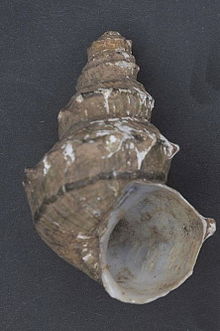Margarya melanioides
| Margarya melanioides | |
|---|---|

| |
| Apertural view of a shell of Margarya melanioides. | |
| Scientific classification | |
| Domain: | Eukaryota |
| Kingdom: | Animalia |
| Phylum: | Mollusca |
| Class: | Gastropoda |
| Subclass: | Caenogastropoda |
| Order: | Architaenioglossa |
| Family: | Viviparidae |
| Genus: | Margarya |
| Species: | M. melanioides
|
| Binomial name | |
| Margarya melanioides | |
| Synonyms[1][4][5] | |
|
Margarya melanoides (spelling error)[1] | |
Margarya melanioides is a species of large operculate freshwater snail, an aquatic gastropod mollusc in the family Viviparidae, the river snails.
Margarya melanioides is the type species of the genus Margarya.[2][6]
Distribution
[edit]The distribution of Margarya melanioides includes Dian Lake, Erhai Lake, Jianhu Lake, Xihu Lake, and Cibi Lake in Yunnan Province, China.[1][5] Former records in Daduitai Lake and Xingyun Lake are considered as a result of the mix-up of species name.[5]
An average population density was 36 individuals per square meter in Dianchi Lake in 1940s,[7] 0.7 individuals per square meter in 1990s[7] and 0.068 individuals per square meter in Dianchi Lake in 2012.[7]
According to the population ecology research by Song et al. (2013),[7] the population of will collapse in the Dian Lake in 2015.[7]
Description
[edit]The width of the shell is up to 64.3 mm. The height of the shell is up to 94.7 mm.[5]
Shu et al. (2010) provided details about the shell and about the radula.[4]
The diploid chromosome number of Margarya melanioides is 2n=18.[4][8]
Ecology
[edit]Margarya melanioides is a dioecious species.[7] Females are ovoviviparous and one female lay 5-6 eggs per year.[7] The newborn shell is about 8 mm in height.[7] The snail will reach maturity in one year in a shell height about 30 mm.[7]
The lifespan is 3–4 years.[7]
Human use
[edit]This species is extensively harvested as a human food source, but harvesting is one of its threats.[7]
References
[edit]- ^ a b c d Aldridge D., Di L., Jiang Y. & McIvor A. (2009). "Margarya melanoides" (sic!). In: IUCN 2013. IUCN Red List of Threatened Species. Version 2013.2. <www.iucnredlist.org>. Downloaded on 22 February 2014.
- ^ a b Nevill G. (1877). "List of the Mollusca brought back by Dr. Anderson from Yunnan and Upper Burma, with descriptions of new species". Journal of the Asiatic Society of Bengal 46(2): 14-41. page 30.
- ^ Mabille J. (1886). "Déscription de vivipares nouvelles du Lac Ta-Ti". Bulletins de la Société malacologique de France 3: 65–76. page 66, plate II, figs 1a, 1b.
- ^ a b c Shu, F.; Köhler, F.; Wang, H. (2010). "On the shell and radular morphology of two endangered species of the genus Margarya Nevill, 1877 (Gastropoda: Viviparidae) from lakes of the Yunnan Plateau, Southwest China". Molluscan Research. 30 (1): 17–24.
- ^ a b c d Zhang, L. J.; Chen, S. C.; Yang, L. T.; Jin, L.; Köhler, F. (2015). "Systematic revision of the freshwater snail Margarya Nevill, 1877 (Mollusca: Viviparidae) endemic to the ancient lakes of Yunnan, China, with description of new taxa". Zoological Journal of the Linnean Society. 174 (4): 760–800. doi:10.1111/zoj.12260.
- ^ Du, L.; Yang, J.; von Rintelen, T.; Chen, X.; Aldridge, D. (2013). "Molecular phylogenetic evidence that the Chinese viviparid genus Margarya (Gastropoda: Viviparidae) is polyphyletic". Chinese Science Bulletin. 58 (18): 2154–2162. doi:10.1007/s11434-012-5632-y.
- ^ a b c d e f g h i j k Song, Zhuoyan; Zhang, Junqian; Jiang, Xiaoming; Wang, Chouming; Xie, Zhicai (2013). "Population structure of an endemic gastropod in Chinese plateau lakes: evidence for population decline". Freshwater Science. 32 (2): 450–461. doi:10.1899/12-099.1.
- ^ Chen Y. X., Zhang N. G., Zhang W. & Li J. K. (1996). "The karyotype study of Margarya yaungtsunghaiensis and M. melanioides (Viviparidae)". Zoological Research 17: 94-96. (In Chinese with English abstract)
External links
[edit]- (in Chinese) Zhang L. (1986). "Study on the morphological variation of Margarya melanioides and M. monodi from Dian-Chi, Yunnan." Transactions of the Chinese Society of Malacology 2: 65–71. (In Chinese with English abstract)

